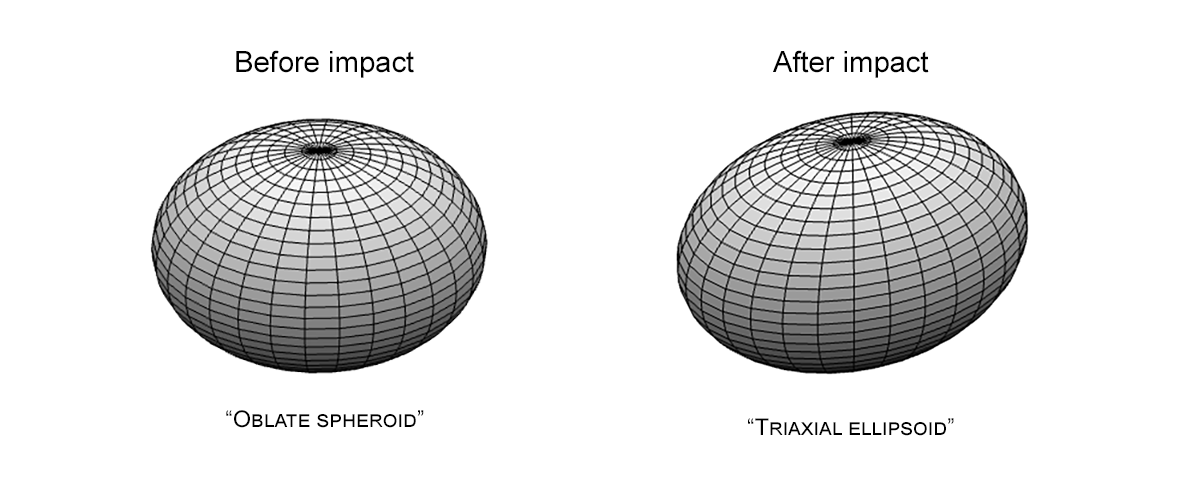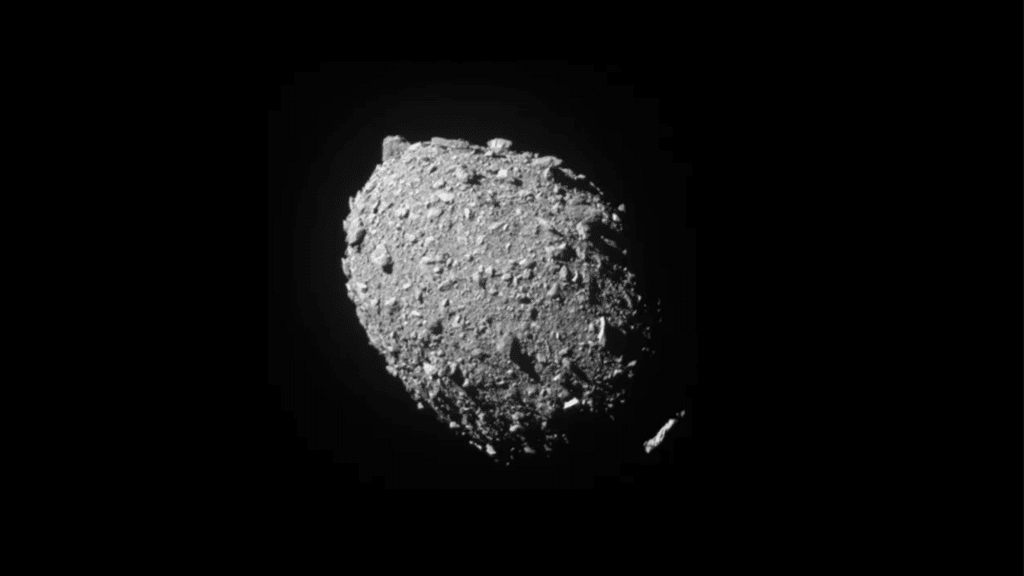In a “perfect” image test, NASA’s DART, which stands for Double Asteroid Redirection Test successfully collided with a small spacecraft into an asteroid in September 2022. The mission showed that a spacecraft could successfully divert a dangerous space rock if it were ever heading for Earth, even though the chances of a disastrous event happening are quite low. DART altered the asteroid’s path, and now scientists found that the intense impact also likely changed the asteroid’s shape. The findings are detailed in a report published on March 19 in the Planetary Science Journal.
DART was aimed at the 560-foot-wide asteroid Dimorphos, which orbits a larger near-Earth asteroid called Didymos. Before the collision, Dimorphos had a generally symmetrical oblate spheroid shape.
“When DART made impact, things got very interesting,” Shantanu Naidu, a study co-author and navigation engineer at NASA’s Jet Propulsion Laboratory (JPL), commented in a statement. “Dimorphos’ orbit is no longer circular. The entire shape of the asteroid has changed, from a relatively symmetrical object to a ‘triaxial ellipsoid’-–something more like an oblong watermelon.”

Previously, it took Dimorphos 11 hours and 55 minutes to complete one loop around Didymos and it had a well-defined, circular orbit about 3,900 feet from it. The space rock’s orbital period–the time it takes to complete one orbit–is now shorter by about 33 minutes and 15 seconds.
To investigate the changes after the impact with DART, Naidu and the team on this study utilized various sources of data in their computer models. The first source was the images that DART captured as it approached the asteroid. These images taken aboard the spacecraft provided close-up measurements of the gap between Didymos and Dimorphos and helped the team gauge the dimensions of both asteroids just before impact.
The second data source was NASA’s Deep Space Network’s Goldstone Solar System Radar. This rader system is located near Barstow, California. It bounced radio waves off both Didymos and Dimorphos. These radio waves accurately measured the position of Dimorphos relative to Didymos after impact. These radar observations helped NASA conclude that DART surpassed the mission’s expectations.
[Related: DART left an asteroid crime scene. This mission is on deck to investigate it.]
The most significant source of data came from ground telescopes all over the world that measured both asteroids’ light curve. This is how the sunlight reflecting off the asteroids’ rocky surfaces changed over time. Comparing the light curves before and after impact helped the team learn how DART changed Dimorphos’ motion. As Dimorphos orbits, it periodically passes in front of Didymos and then behind it. During these mutual events, one of the asteroids in the system can cast a shadow on the other, or block our view from Earth. A temporary dimming in the light curve can be recorded by telescopes in both scenarios.
The team used the timing of this series of changes in light brightness to understand the shape of the orbit. Their models showed that Dimorphos’ orbit is now slightly stretched out, or not perfectly circular.
“Before the collision, the events happened at regular intervals, indicating a circular orbit. After the collision, there were small timing differences, showing that something was off,” said study co-author and JPL senior research scientist Steve Chesley. said in a statement. “We never expected to get this kind of accuracy.”
[Related: Smashed asteroid surrounded by a ‘cloud’ of boulders.]
According to the team, the models are so exact that they can even demonstrate that Dimorphos moves back and forth as it circles Didymos.
The models also calculated how the time it takes to complete an orbit changed. Right after the collision, DART decreased the average distance between the two asteroids. It made Dimorphos’ orbital period 32 minutes and 42 seconds shorter, down to 11 hours, 22 minutes, and 37 seconds.
In the weeks following its collision with DART, the asteroid’s orbital period continued to decrease as it lost more rocky material. It settled at 11 hours, 22 minutes, and 3 seconds per orbit–or 33 minutes and 15 seconds less time than before the collision. Dimorphos also now has an average orbital distance of about 3,780 feet–or roughly 120 feet closer to Didymos than before colliding with DART.
Another study published in February found that the asteroid is likely a loose rubble pile asteroid–similar to the recently sampled asteroid Bennu–composition due to its collision with DART.
“The results of this study agree with others that are being published,” said lead scientist for solar system small bodies at NASA Headquarters Tom Statler. said in a statement. “Seeing separate groups analyze the data and independently come to the same conclusions is a hallmark of a solid scientific result. DART is not only showing us the pathway to asteroid-deflection technology, it’s revealing [a] new fundamental understanding of what asteroids are and how they behave.” Statler was not an author on this study.
To get a closer look at Didymos and Dimorphos, the European Space Agency’s Hera mission is scheduled to launch in October 2024. It will be taking a detailed survey of the asteroid pair and could officially confirm just how much DART reshaped Dimorphos.









